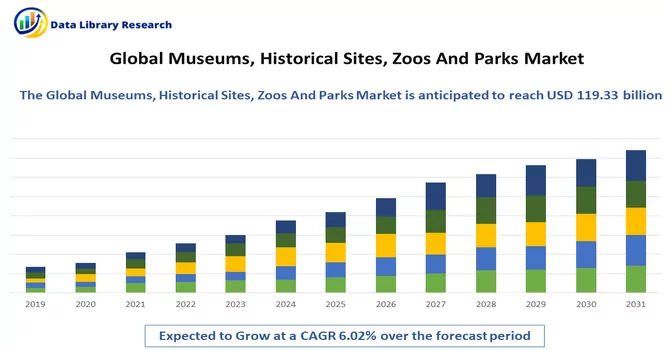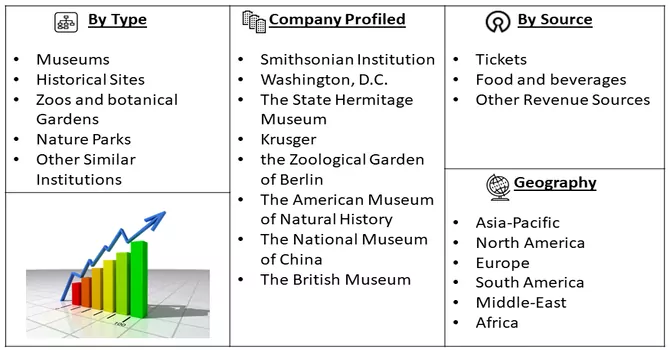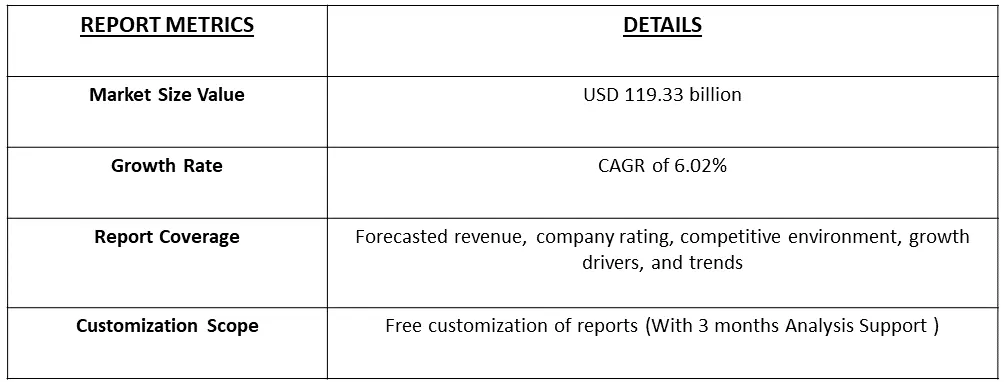The global market for museums, historical sites, zoos, and parks is projected to reach USD 119.33 billion by 2027, with an anticipated growth rate of 6.02% during the forecast period from 2023 to 2030.

Get Complete Analysis Of The Report - Download Free Sample PDF
This sector comprises establishments that provide diverse cultural, historical, educational, and recreational experiences to the public. Encompassing museums showcasing art, history, and science exhibits, historical sites preserving and interpreting the past, zoos housing and exhibiting wildlife, and parks offering outdoor recreational spaces, these entities serve as integral hubs for cultural enrichment, learning, and entertainment.
Museums and historical sites play a pivotal role in safeguarding and presenting cultural heritage and historical artefacts. They contribute significantly to fostering an understanding and appreciation of various cultures and histories. These attractions operate as educational platforms, delivering curated exhibits, interactive displays, and educational programs tailored for students, researchers, and the general public. Moreover, museums, historical sites, zoos, and parks are substantial tourist magnets, drawing visitors from both local and international locations. This not only contributes to the tourism industry but also bolsters the local economy. Parks, in particular, offer recreational spaces for individuals and families, presenting opportunities for outdoor activities, sports, and leisure pursuits. Overall, this sector stands as a multifaceted contributor to global tourism, education, and cultural preservation.
There has been a notable increase in the adoption of virtual exhibits and online tours within the industry, enabling visitors to remotely explore museums, historical sites, and zoos. Digital platforms play a pivotal role in enhancing accessibility and engagement, allowing individuals to access these cultural and recreational experiences from the comfort of their own homes. Institutions are making strategic investments in immersive and interactive exhibits that transcend traditional displays, incorporating technologies such as virtual reality (VR), augmented reality (AR), and multimedia installations. These cutting-edge technologies contribute to creating captivating and memorable experiences for visitors. Furthermore, there is a growing trend in zoos and parks to integrate sustainability initiatives, emphasizing eco-friendly practices, and imparting education to visitors about environmental conservation. Themes related to climate change and biodiversity are gaining prominence, reflecting a heightened awareness of the importance of ecological preservation. The industry is increasingly aligning itself with the broader global movement towards sustainability, aiming to not only entertain but also educate visitors on the significance of responsible environmental practices. This dual focus on digital innovation and environmental consciousness positions the industry at the forefront of providing enriched, impactful, and forward-thinking experiences for its diverse audience.
Market Segmentation: The Museums, Historical Sites, Zoos, And Parks are Segmented by Type (Museums, Historical Sites, Zoos and botanical Gardens, Nature Parks, and Other Similar Institutions), by Revenue Source (Tickets, Food and beverages, and Other Revenue Sources), and by Geography (North America, Europe, Asia-Pacific, Latin America, and Middle-East and Africa). The market sizes and forecasts are provided in terms of value (USD billion) for all the above segments.

For Detailed Market Segmentation - Download Free Sample PDF
Market Drivers:
Cultural Enrichment and Education
Museums, historical sites, zoos, and parks play a pivotal role as essential educational platforms, providing visitors with the chance to delve into a wide array of subjects, including history, science, art, and wildlife. The primary impetus lies in fostering cultural enrichment and facilitating knowledge acquisition, serving as a key driver that draws individuals, families, and school groups seeking informative and engaging experiences. For instance, an article published by the National Institute of Library in 2022, reported that a survey conducted by the World Association of Zoos and Aquariums, in collaboration with national and regional zoo and aquarium associations, showed that annually more than 700 million people visit zoos and aquariums worldwide and are thus potentially exposed to environmental education.
Tourism and Economic Impact:
The sector holds a central position in global tourism, serving as key attractions that magnetize visitors from diverse regions. Its economic influence is substantial, with revenue generated from ticket sales, merchandise, concessions, and related services. Museums, historical sites, zoos, and parks actively contribute to local economies, providing vital support to jobs and businesses in the surrounding areas. The tourism-driven economic impact stands out as a primary catalyst for the ongoing growth and advancement of these cultural and recreational venues. Museums serve as cultural landmarks, offering visitors an opportunity to delve into the heritage, history, and artistic expressions of a destination. Tourists are often motivated to explore museums to gain a deeper understanding of the local culture and traditions. For instance, an article published by World Tourism Organization published article in 2020, reported that 1.5 billion international tourist arrivals were recorded in 2019, globally. Thus, the synergy between tourism and museum visits creates a mutually beneficial relationship. Tourists find inspiration and enrichment in the cultural offerings of museums, while these institutions, in turn, receive support and recognition from the tourism sector, contributing to a holistic and vibrant travel experience. Thus, such instances are driving the growth of the studied market over the forecast period.
Market Restraints :
Financial Constraints and Visitor Decline and Changing Demographics
Institutions within this sector grapple with significant operational expenses associated with maintenance, security, staffing, and conservation endeavours. Financial challenges, encompassing budgetary constraints and uncertainties in funding, can hinder the capacity to uphold and improve facilities. The evolving preferences of visitors, notably among younger demographics, towards digital experiences and alternative forms of entertainment may result in a decrease in physical visitation to these venues. Adapting to shifting demographics and changing preferences presents a formidable challenge for traditional cultural and recreational institutions.
Numerous museums, historical sites, zoos, and parks globally encountered temporary closures or limitations on visitor capacity during the initial stages of the pandemic. Lockdowns and social distancing mandates, implemented to mitigate the spread of the virus, caused a notable decrease in physical attendance. The closure of these venues and the imposition of restrictions on visitor numbers translated into considerable revenue setbacks for these institutions. The industry heavily depends on income sources such as ticket sales, memberships, and merchandise, and the abrupt interruption of these revenue streams posed substantial financial challenges.
Segmentation Analysis:
Museums Segment is Expected to Witness Significant Growth Over the Forecast Period
Museums experienced temporary closures as a component of lockdown measures implemented to mitigate the spread of the virus. These closures disrupted routine operations, impacting exhibition schedules, educational programs, and events. The shutdown of museums gave rise to notable financial challenges, as these institutions heavily depend on revenue sources such as visitor admissions, memberships, and donations. The abrupt cessation of these income streams imposed considerable financial strain. Consequently, many institutions confronted budget shortfalls, compelling them to implement cost-cutting measures in order to navigate the financial constraints imposed by the closures. Thus, owing to such benefits, the segment is expected to witness significant growth over the forecast period.
Food & Beverages Segment is Expected to Witness Significant Growth Over the Forecast Period
During lockdowns, the closure of museums and other cultural venues extended to the temporary shutdown of on-site dining facilities, impacting restaurants, cafes, and food kiosks within these establishments. The suspension of on-site dining resulted in a considerable loss of revenue for the food and beverage outlets. The financial strain posed challenges for businesses operating within these cultural institutions, and sustaining operations became a hurdle for some. Thus, to respond to evolving circumstances, certain food and beverage outlets adopted alternative strategies such as implementing takeout and delivery services. This allowed them to continue serving visitors who preferred off-site dining options, all while adhering to public health guidelines. This adaptive approach enabled these establishments to navigate the challenges posed by the closure of on-site dining facilities. Thus, owing to such benefits, the segment is expected to witness significant growth over the forecast period.
Europe Region is Expected to Witness Significant Growth Over the Forecast Period
Museums in Europe stand as rich repositories of the continent's cultural, historical, and artistic heritage, offering visitors a profound journey through the tapestry of its diverse civilizations. Europe boasts an unparalleled wealth of museums, each reflecting the unique narratives of its respective region and contributing to the continent's status as a global cultural hub.
The implementation of audio tours in museums contributes to heightened visitor engagement, improved accessibility, and the provision of more comprehensive information for an unbiased educational experience. The Louvre Museum in France, attracting approximately 8 million annual visitors, has integrated audio tours to deliver interactive content about its artworks. Other prominent institutions, such as the British Museum in London, the San Francisco Museum of Modern Art, and the Auckland War Memorial Museum in New Zealand, similarly provide visitors with pre-recorded audio guides to enhance their museum experience.
Furthermore, in September 2022, the Museum of Homelessness (MoH) revealed its intentions to establish its inaugural site at Manor House Lodge within Finsbury Park, London. The museum's development will unfold through collaboration with residents and community groups. The facility will feature workshops, talks, and performances curated by individuals with lived experiences of homelessness. Additionally, the designs encompass an open-access art studio specifically designed for those currently experiencing homelessness. Thus, such instances are driving the growth of the studied market in the region.

Get Complete Analysis Of The Report - Download Free Sample PDF
Museums, Historical Sites, Zoos, And Parks Market Competitive Analysis:
The market is expected to be concentrated with the presence of a large number of players. Acquisitions are a strategic means for companies to expand their market presence, diversify their product portfolios, and acquire complementary technologies or expertise. By acquiring other businesses, companies can swiftly enter new markets or strengthen their position in existing ones. Some of the major players present in the market are:
Recent Developments:
1) In March 2023, Young V&A announced, it will open its doors in Bethnal Green on Saturday 1 July - in time for the summer holidays!, after a project that has seen it be transformed from its former iteration as the V&A Museum of Childhood.
2) In March 2023, The Columbus Zoo and Aquarium and The Wilds, its wildlife conservation centre, announced a capital spending program to stretch over the next 12 to 18 months. Projects include improvements to animal well-being, enhanced guest experiences, and additional lodging. Approximately USD 32.5 million is set aside for the redevelopment of the North American region.
Q1. What is the Growth Rate of the Museums, Historical Sites, Zoos And Parks Market ?
Museums, Historical Sites, Zoos And Parks Market anticipated growth rate of 6.02% during the forecast period.
Q2. What segments are covered in the Museums, Historical Sites, Zoos And Parks Market Report?
By Type, By Revenue Growth and Geography these segments are covered in the Museums, Historical Sites, Zoos And Parks Market Report.
Q3. Which Region is expected to hold the highest Market share?
Europe region is expected to hold the highest Market share.
Q4. Who are the key players in Museums, Historical Sites, Zoos And Parks Market?
Some key players operating in the market include
Data Library Research are conducted by industry experts who offer insight on industry structure, market segmentations technology assessment and competitive landscape (CL), and penetration, as well as on emerging trends. Their analysis is based on primary interviews (~ 80%) and secondary research (~ 20%) as well as years of professional expertise in their respective industries. Adding to this, by analysing historical trends and current market positions, our analysts predict where the market will be headed for the next five years. Furthermore, the varying trends of segment & categories geographically presented are also studied and the estimated based on the primary & secondary research.
In this particular report from the supply side Data Library Research has conducted primary surveys (interviews) with the key level executives (VP, CEO’s, Marketing Director, Business Development Manager and SOFT) of the companies that active & prominent as well as the midsized organization
FIGURE 1: DLR RESEARH PROCESS

Extensive primary research was conducted to gain a deeper insight of the market and industry performance. The analysis is based on both primary and secondary research as well as years of professional expertise in the respective industries.
In addition to analysing current and historical trends, our analysts predict where the market is headed over the next five years.
It varies by segment for these categories geographically presented in the list of market tables. Speaking about this particular report we have conducted primary surveys (interviews) with the key level executives (VP, CEO’s, Marketing Director, Business Development Manager and many more) of the major players active in the market.
Secondary ResearchSecondary research was mainly used to collect and identify information useful for the extensive, technical, market-oriented, and Friend’s study of the Global Extra Neutral Alcohol. It was also used to obtain key information about major players, market classification and segmentation according to the industry trends, geographical markets, and developments related to the market and technology perspectives. For this study, analysts have gathered information from various credible sources, such as annual reports, sec filings, journals, white papers, SOFT presentations, and company web sites.
Market Size EstimationBoth, top-down and bottom-up approaches were used to estimate and validate the size of the Global market and to estimate the size of various other dependent submarkets in the overall Extra Neutral Alcohol. The key players in the market were identified through secondary research and their market contributions in the respective geographies were determined through primary and secondary research.
Forecast Model
